Course: the half marathons I’ve previously run were loops or out-and-backs on paved roads. Both had hilly sections, but were mostly flat. The Pikes Peak Ascent starts on a paved road, but soon transitions to a dirt road and then a steep trail. The trail surface ranged from crushed rock, to forest floor, to solid granite. Running on pavement is hard on the knees, but stepping from boulder to boulder offers even less cushion! The Pikes Peak trail is relentlessly uphill (an elevation gain of 7,815 feet). Each time I reached one of the few and brief downhill or flat sections, I took a moment to appreciate the sensation of standing upright. And then I leaned into the mountain, again.
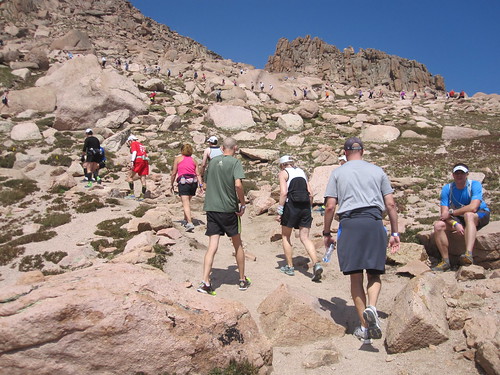
A line of brightly dressed racers highlight the switchbacks above the treeline.
Pace: I never expected to run up the trail. First of all, I wasn’t able to practice running up a 13-mile, steep grade at altitude. Secondly, the trail is often too narrow to pass others. Most of us completed the race at a fast walk. At times, we even came to a dead stop, waiting for slower folks to navigate a tight turn or squeeze. I run half-marathons in Cincinnati at a 9:30-ish pace. I completed this event at an average of a 24 minute-per-mile pace. It is possible to run up the trail (my neighbor made it up in 2:51), but you’ve got to train for it and start at the head of the pack.
Spectators: the Cincinnati Flying Pig course is lined with well-wishers holding signs and shouting encouragement. Due to the remote nature of the Ascent, I only saw spectators at the beginning of the race and at the end. So it was up to the participants to encourage one another. I hooted and hollered and cheered on everyone I passed. In fact, I might have been a little annoying! But the activity energized me and, I hope, motivated others.
Support: despite the difficulty accessing the trail, the race organizers were able to provide water, Gatorade, and food every few miles. Twice, a hose was dragged in to refill personal water bottles. Elsewhere, the volunteers packed in water and distributed it from pitchers and cups. In between stops, we were on our own. There were no quick stops at convenience store or trays of orange slices offered by friendly spectators.
Medical support was similarly limited. Members of the local search and rescue were on hand at refreshment stops and at a few other locations. (I’m guessing they chose the additional spots based on past years’ incidents.) Once, we all moved aside as emergency personnel ran down the trail past us, but I didn’t see any cases of medical emergencies, myself. Beefy did report seeing vomiting at the top and at least one person carried up the mountain.
And speaking of vomiting and passing out, I’d be remiss if I didn’t recognize the Hash House Harriers for offering beer halfway up the Golden Stairs. As we climbed the last few hundred feet to the top of the mountain, we were invited to pause, enjoy some Pabst Blue Ribbon, and appreciate the view. I was sure to limit my drink to only a few ounces.
Trash: water was provided in disposable cups and designated “trash zones” were marked for a few yards following each rest stop. We were instructed to drop our used cups and other garbage on the trail in these zones for clean-up by volunteers. Outside of the zones, we packed it out. I was pleased to see very little litter left by the race participants ahead of me.
Restrooms: I’m accustomed to the familiar slap of porta-potty doors along the race course. On the trail up Pikes Peak, though, one peed with nature or not at all.
Camaraderie: I’m an antisocial runner. I train alone and I plug into my iPod for most of a race. The Pikes Peak events disallow use of headphones. Given the trail conditions and the crowding, it isn’t safe to disconnect with audio entertainment. More importantly, I’d have missed out on the most fun aspect of the event: interacting with the other participants! Many of us were racing alone and made connections on the trail to pass the time and provide encouragement. I struck up multiple conversations and made a “race buddy,” too. Bill and I started chatting a few miles in and stuck together for the remainder of the race. He’s from Colorado Springs and was determined not to let a “flat-lander” kick his butt.
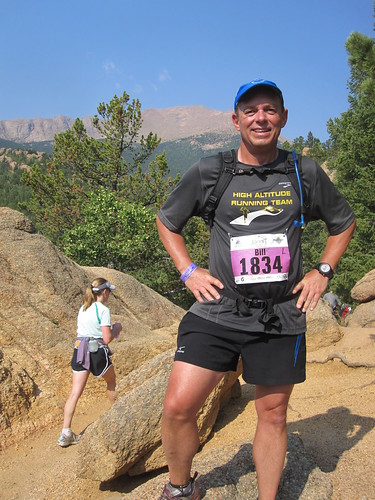
My new friend Bill. Pikes Peak is the brown mountain, behind him.
Views: the Cincinnati races are not ugly. The city skyline, river, and bridges are picturesque. But it can’t compare to the views offered on the trail up Pikes Peak. I was enchanted, early on, by the forest, rock formations, and quaint footbridges. Once we left the treeline, the views blew me away. I reminded myself, often, to look up from the trail and appreciate the scenery. (This invariably resulted in me tripping, but was totally worth it.)
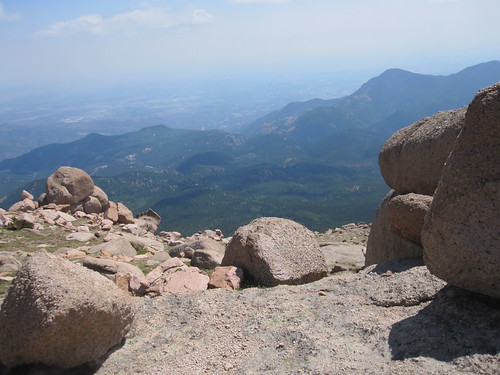
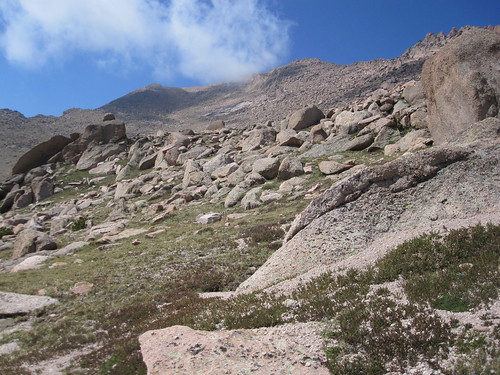
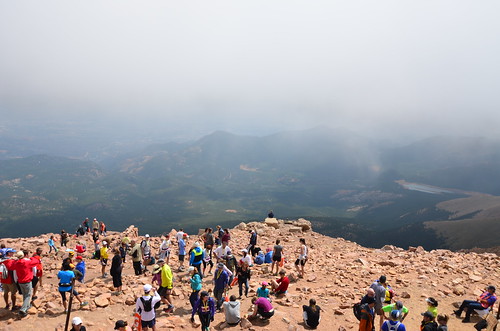

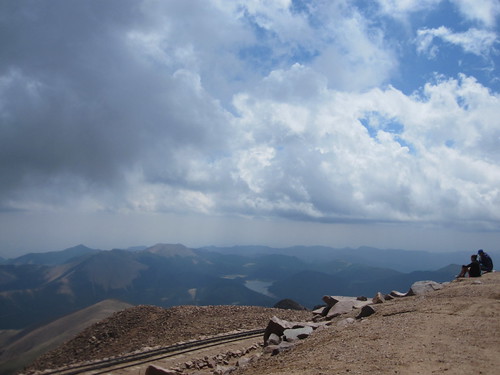
I usually leave a race low on energy and glad to be done. After the Ascent, I was totally high. I had a donut at the summit, danced in line while awaiting transportation, and leapt off the bus in Manitou Springs. I can’t wait to race up Pikes Peak again next year!
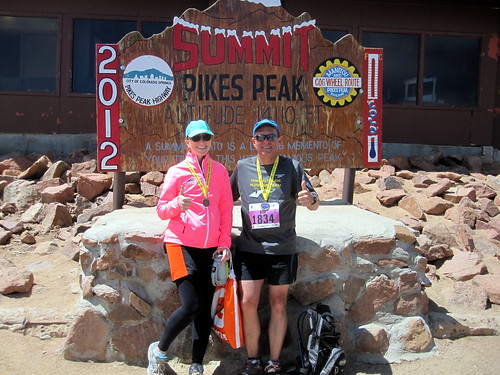
Sporty Sunday is a recurring feature in which I share my fitness routine and offer and solicit advice. While this content might seem a little out of place in an outfit diary, a healthy, strong body is the foundation of my wardrobe. I hope to inspire my readers to be fit as well as stylish!
5 comments:
Thanks for sharing your race experience with us. It looks like you had a great time!
Sounds amazing! Well done!
Well done, sounds like an amazing race.
I can sense your joy!
Sounds like a great experience! Thanks for taking the time to do a writeup.
FWIW, if you "disconnect" from audio in regular races, you can often socialize, take in more atmosphere, & meet race buddies (plus better stay out of other people's way)... this phenomenon is not limited to Pikes Peak Ascent! ;) Seriously, I'm sure sharing your energy & good vibes in normal races would be greatly appreciated by others around you!
Keep on running!
Post a Comment